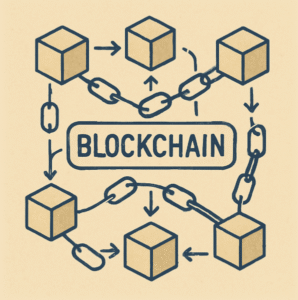Blockchain is a distributed ledger technology that allows multiple parties to have simultaneous access to a constantly updated digital ledger that cannot be altered. This technology underpins cryptocurrencies like Bitcoin but has far broader applications, particularly in financial markets. Let’s delve deeper into the fundamental aspects of blockchain technology.
What is Blockchain?
Blockchain is essentially a chain of blocks, where each block contains a list of transactions. These blocks are linked using cryptographic hashes, ensuring the integrity and immutability of the data. Each participant in the network, known as a node, maintains a copy of the entire blockchain, making it a decentralized ledger. This decentralization is the cornerstone of blockchain’s robustness, eliminating the risk of a single point of failure.
Historical Evolution of Blockchain
The concept of blockchain first emerged with the advent of Bitcoin in 2008, introduced by the pseudonymous figure Satoshi Nakamoto. Initially designed as a public transaction ledger for the cryptocurrency, the technology has since evolved, finding applications beyond digital currencies. Various versions of blockchain have been developed, including private and consortium blockchains, each catering to different use cases and industries.
Broader Applications Beyond Finance
While blockchain’s most famous application is in cryptocurrencies, its potential extends far beyond. In supply chain management, blockchain can provide end-to-end visibility and traceability of goods. In healthcare, it can secure patient records and streamline data sharing between institutions. These diverse applications underscore blockchain’s versatility and its potential to disrupt multiple sectors.
Key Features of Blockchain
- Decentralization: Unlike traditional trading platforms that rely on a central authority, blockchain operates on a decentralized network, reducing the risk of a single point of failure. Decentralization empowers users by distributing control across the network, thereby enhancing system robustness and trust.
- Transparency: Transactions on a blockchain are visible to all participants, fostering trust and accountability. This transparency ensures that all parties have access to the same information, reducing the likelihood of disputes and promoting fair practices.
- Security: Blockchain uses cryptographic methods to secure data, making it highly resistant to fraud and cyberattacks. Each transaction is encrypted and linked to the previous one, forming a secure, tamper-proof chain that is nearly impossible to alter without consensus from the network.
- Efficiency: By eliminating intermediaries and streamlining processes, blockchain can significantly reduce transaction times and costs. This efficiency is achieved through smart contracts, which automate and enforce contract terms without the need for intermediaries.

Blockchain’s Influence on Trading Platforms
Blockchain technology is set to revolutionize trading platforms by introducing unprecedented levels of security, transparency, and efficiency. Let’s explore how blockchain is reshaping the infrastructure of stock trading.
Enhanced Security and Transparency
One of the most compelling benefits of blockchain in stock trading is enhanced security. Traditional trading platforms are susceptible to hacking and fraud, but blockchain’s cryptographic security measures make it incredibly difficult for unauthorized parties to alter transaction records. This security is coupled with transparency, as all transactions are recorded on a public ledger that is accessible to all participants.
The Role of Cryptography in Security
Cryptography is integral to blockchain’s security framework. It employs complex mathematical algorithms to encrypt transaction data, ensuring that only authorized parties can access it. This cryptographic layer acts as a formidable barrier against hacking attempts and unauthorized access, safeguarding the integrity of the trading process.
Transparency as a Trust Builder
The transparency inherent in blockchain fosters trust among trading participants. Every transaction is recorded and timestamped, creating an auditable trail that can be independently verified. This openness mitigates the risk of fraudulent activities and enhances confidence in the trading system.
Case Studies of Enhanced Security
Numerous exchanges have implemented blockchain to bolster security. For instance, the Gibraltar Stock Exchange has adopted blockchain to enhance transaction security and ensure compliance with international standards. These real-world examples highlight blockchain’s efficacy in fortifying trading platforms.
Reduction of Intermediaries
Traditionally, stock trading involves multiple intermediaries, such as brokers, clearinghouses, and exchanges, each adding complexity and cost. Blockchain can streamline this process by enabling peer-to-peer trading. This reduces the need for intermediaries, potentially lowering transaction fees and speeding up the settlement process.
Peer-to-Peer Trading Explained
Peer-to-peer (P2P) trading on blockchain enables direct transactions between buyers and sellers. By eliminating the need for intermediaries, P2P trading reduces transaction costs and minimizes settlement times. This direct interaction simplifies the trading process and enhances market fluidity.
The Cost Implications of Reducing Intermediaries
The reduction of intermediaries can lead to significant cost savings for traders. By bypassing brokers and clearinghouses, blockchain reduces commission fees and administrative expenses. These savings can be particularly beneficial for high-frequency traders who engage in large volumes of transactions.
Streamlined Settlement Processes
Blockchain’s ability to facilitate near-instantaneous settlements is a game-changer. Traditional settlement processes can take days, tying up capital and creating risks. Blockchain’s rapid settlement capability frees up capital, reduces counterparty risk, and enhances market efficiency.
Improved Efficiency in Algorithmic Trading
Algorithmic trading relies heavily on speed and accuracy. Blockchain can enhance algorithmic trading by providing a faster, more reliable infrastructure. With blockchain, trades can be executed, verified, and settled in near real-time, which is a significant improvement over the current system that can take days to finalize trades.
Speed and Accuracy in Trading
Blockchain’s decentralized network ensures that trades are processed swiftly and accurately. The technology’s efficiency enables high-frequency trading algorithms to execute large volumes of trades at lightning speed, maximizing profit opportunities and minimizing risks.
The Role of Smart Contracts
Smart contracts on blockchain automate trading processes by executing predefined rules without human intervention. These self-executing contracts enhance accuracy and reduce the potential for human error, making algorithmic trading more reliable and efficient.
Case Studies of Algorithmic Trading
Several trading firms have integrated blockchain into their algorithmic trading systems. For example, the DECOM cryptocurrency exchange utilizes blockchain to optimize its high-frequency trading operations, demonstrating blockchain’s potential to enhance trading efficiency.

The Impact on Stock Market Technology
Blockchain is poised to redefine stock market technology by introducing new efficiencies and reducing costs. Here’s how:
Real-Time Settlement
Traditionally, stock trades take several days to settle, which ties up capital and creates risk. Blockchain can enable real-time settlement, freeing up capital and reducing risk, which is particularly advantageous for institutional investors seeking to optimize their portfolios.
The Traditional Settlement Process
In the traditional stock market, trades often undergo a T+2 settlement cycle, meaning they settle two business days after the transaction. This delay can tie up capital and expose traders to market fluctuations and counterparty risk.
Blockchain’s Advantage in Real-Time Settlement
Blockchain enables trades to settle in real time by validating and recording transactions instantly. This real-time capability reduces settlement risk, frees up capital, and enhances liquidity in the market. Institutional investors, in particular, benefit from this increased efficiency, allowing them to reinvest capital more swiftly.
Examples of Real-Time Settlement
Several stock exchanges are experimenting with blockchain to achieve real-time settlement. The Australian Securities Exchange (ASX) is transitioning to a blockchain-based system to expedite settlement processes, setting a precedent for other exchanges globally.
Greater Market Access
Blockchain can democratize access to stock markets. By lowering barriers and reducing costs, blockchain can make stock trading more accessible to a broader range of investors, including those who may have been previously excluded due to high fees or complex processes.
Lowering Barriers to Entry
Blockchain reduces entry barriers by minimizing transaction costs and simplifying trading procedures. These reduced costs enable retail investors to participate in stock markets, fostering a more inclusive financial ecosystem.
Enhancing Inclusivity in Trading
Blockchain’s decentralized nature empowers individual investors by granting them equal access to market opportunities. This inclusivity is particularly impactful in developing regions where traditional financial systems may be less accessible.
Case Studies of Enhanced Market Access
Several blockchain-based platforms, such as Robinhood and eToro, have emerged to democratize trading. By leveraging blockchain, these platforms offer commission-free trading, attracting a diverse range of investors and promoting financial inclusion.
Enhanced Regulatory Compliance
Regulatory compliance in stock trading is complex and costly. Blockchain’s transparent and immutable record-keeping can simplify compliance by providing regulators with a clear, real-time view of trading activities. This can help corporate finance professionals better navigate regulatory shifts and develop strategies that align with evolving requirements.
Simplifying Regulatory Processes
Blockchain’s transparent ledger provides regulators with instant access to transaction records, simplifying compliance audits. This transparency reduces the administrative burden on trading firms, allowing them to focus on strategic growth.
Reducing Compliance Costs
Blockchain’s automated record-keeping reduces the costs associated with regulatory compliance. By eliminating manual processes and reducing the likelihood of errors, blockchain enables firms to allocate resources more efficiently.
Case Studies of Regulatory Compliance
The integration of blockchain in regulatory frameworks is gaining traction. For instance, the Monetary Authority of Singapore is exploring blockchain for regulatory reporting, demonstrating the technology’s potential to streamline compliance processes.
Real-World Applications and Case Studies
Several initiatives and pilots are already exploring blockchain’s potential in stock trading:
ASX and Digital Asset Holdings
The Australian Securities Exchange (ASX) is transitioning to a blockchain-based system for clearing and settling trades. This move is expected to enhance efficiency and reduce costs significantly, serving as a model for other exchanges worldwide.
The Transition Process
ASX’s transition to blockchain involves replacing its existing CHESS system with a distributed ledger technology developed by Digital Asset Holdings. This process involves extensive testing and collaboration with stakeholders to ensure a seamless migration.
Expected Benefits for the ASX
The shift to a blockchain-based system is anticipated to reduce settlement times, enhance security, and lower operational costs. These improvements are expected to boost investor confidence and attract more participants to the exchange.
Setting a Global Standard
ASX’s adoption of blockchain sets a global precedent, encouraging other exchanges to explore similar innovations. This pioneering move underscores the potential of blockchain to revolutionize stock market operations.
Nasdaq and Linq
Nasdaq has partnered with blockchain startup Linq to allow private companies to trade shares using blockchain technology. This initiative aims to improve the efficiency and security of trading private company shares, making it easier for startup entrepreneurs to raise capital.
The Partnership Objectives
Nasdaq’s partnership with Linq aims to create a blockchain-based platform for trading private company shares. This platform seeks to enhance liquidity and transparency in private markets, benefiting startups and investors alike.
Facilitating Capital Raising
By streamlining the trading process, blockchain makes it easier for startups to raise capital. The technology provides a transparent and secure environment for investors, reducing the risks associated with private equity investments.
Broader Implications for Private Markets
Nasdaq’s initiative highlights blockchain’s potential to transform private markets. By enhancing transparency and reducing friction, blockchain can unlock new opportunities for growth and innovation in the private sector.

Challenges and Considerations
While the potential benefits of blockchain in stock trading are substantial, there are also challenges to consider:
Technological Integration
Integrating blockchain with existing trading systems can be complex and costly. Companies need to invest in technology and training to ensure a smooth transition.
The Complexity of Integration
Integrating blockchain into existing systems involves overcoming technical challenges related to interoperability and scalability. Firms must navigate these complexities to ensure a seamless transition to blockchain-based trading.
Investment in Technology and Training
Adopting blockchain requires significant investment in technology infrastructure and employee training. Companies must allocate resources for system upgrades and workforce development to maximize the benefits of blockchain integration.
Strategies for Successful Integration
To facilitate successful integration, firms can adopt a phased approach, starting with pilot projects to test blockchain’s feasibility. Collaborating with technology partners and industry experts can also streamline the transition process.
Regulatory Uncertainty
The regulatory environment for blockchain and cryptocurrencies is still evolving. Companies must navigate this uncertainty carefully to avoid legal pitfalls and ensure compliance.
Navigating Legal Complexities
The evolving regulatory landscape poses challenges for firms adopting blockchain. Companies must stay abreast of regulatory developments and engage with policymakers to ensure compliance and mitigate legal risks.
The Role of International Standards
Developing international standards for blockchain can provide clarity and consistency in regulatory frameworks. Collaboration among regulators, industry leaders, and technology experts is crucial to establish these standards.
Case Studies of Regulatory Adaptation
Several jurisdictions, such as Malta and Estonia, have implemented blockchain-friendly regulations to foster innovation. These examples demonstrate the potential for regulatory frameworks to adapt and support the growth of blockchain technology.
Market Adoption
Widespread adoption of blockchain technology in stock trading requires buy-in from multiple stakeholders, including exchanges, brokers, and regulators. Building consensus and trust in the technology is crucial for its success.
Building Stakeholder Consensus
Achieving widespread adoption requires collaboration among industry stakeholders. Exchanges, brokers, and regulators must align their interests and work together to promote blockchain’s benefits and address concerns.
Overcoming Resistance to Change
Resistance to change can hinder blockchain adoption. Firms must communicate the advantages of blockchain clearly and provide support to stakeholders to ease the transition.
Promoting Trust and Transparency
Trust is essential for blockchain adoption. By demonstrating the technology’s security and transparency, firms can build confidence among stakeholders and accelerate adoption rates.
Conclusion
Blockchain technology holds the promise of transforming stock trading by enhancing security, reducing costs, and increasing efficiency. For institutional investors, corporate finance professionals, and startup entrepreneurs, understanding and leveraging blockchain can provide a significant competitive advantage. As the technology continues to evolve, staying informed and adaptable will be key to capitalizing on the opportunities blockchain presents in the financial markets.
In summary, while challenges remain, the role of blockchain in stock trading is poised to grow, offering new pathways for innovation in trading platforms, algorithmic trading, and stock market technology as a whole. By embracing blockchain, the financial industry can unlock new levels of efficiency, security, and accessibility, paving the way for a more inclusive and resilient market ecosystem.

